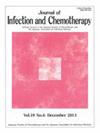Teicoplanin total trough concentration and adverse effects in patients with hypoalbuminemia
IF 1.5
4区 医学
Q3 INFECTIOUS DISEASES
引用次数: 0
Abstract
Background
The association between Teicoplanin (TEIC) total trough concentration (Cmin) and adverse effects (hepatotoxicity, nephrotoxicity, and thrombocytopenia) in patients with hypoalbuminemia remains poorly understood. We examined this association for patients with hypoalbuminemia from a safety perspective.
Methods
This retrospective study included adult patients (≥18 years) who received TEIC at Kyushu Medical Center between April 2013 and March 2024, underwent therapeutic drug monitoring, and had persistent serum albumin <2.5 g/dL. The primary outcome was the occurrence of hepatotoxicity, nephrotoxicity, and thrombocytopenia. Multivariate logistic regression analysis evaluated the association between TEIC Cmin and each adverse event.
Results
Hepatotoxicity, nephrotoxicity, and thrombocytopenia were reported in 13.5 % (33/245), 19.0 % (42/221), and 14.4 % (22/153) of patients, respectively. TEIC Cmin ≥ 21.1 μg/mL, serum albumin <2.0 g/dL, and total parenteral nutrition were associated with hepatotoxicity. Hepatitis/liver cirrhosis and vasopressor use were associated with nephrotoxicity. The factors associated with thrombocytopenia included estimated glomerular filtration rate <30 mL/min/1.73 m2, platelet counts ≤150 × 103/μL, hyperuricemia, and hematologic disorders.
Conclusions
Our findings suggest that a TEIC Cmin ≥ 21.1 μg/mL may increase the risk of TEIC-induced hepatotoxicity in patients with hypoalbuminemia. These findings may need to be validated in further studies.
替柯planin在低白蛋白血症患者中的总谷浓度及不良反应。
背景:Teicoplanin (TEIC)总谷浓度(Cmin)与低白蛋白血症患者不良反应(肝毒性、肾毒性和血小板减少症)之间的关系尚不清楚。我们从安全性的角度研究了低白蛋白血症患者的这种关联。方法:回顾性研究纳入2013年4月至2024年3月在九州医疗中心接受TEIC治疗的成人患者(≥18岁),接受治疗药物监测,血清白蛋白持续< 2.5 g/dL。主要结局是肝毒性、肾毒性和血小板减少的发生。多因素logistic回归分析评估TEIC Cmin与各不良事件之间的关系。结果:13.5%(33/245)、19.0%(42/221)和14.4%(22/153)的患者报告肝毒性、肾毒性和血小板减少。TEIC Cmin≥21.1 μg/mL、血清白蛋白< 2.0 g/dL、总肠外营养与肝毒性相关。肝炎/肝硬化和血管加压剂的使用与肾毒性相关。与血小板减少相关的因素包括肾小球滤过率< 30ml /min/1.73m2,血小板计数< 150×103/μL,高尿酸血症和血液学疾病。结论:TEIC Cmin≥21.1 μg/mL可能增加TEIC所致低白蛋白血症患者肝毒性的风险。这些发现可能需要在进一步的研究中得到验证。
本文章由计算机程序翻译,如有差异,请以英文原文为准。
求助全文
约1分钟内获得全文
求助全文
来源期刊

Journal of Infection and Chemotherapy
INFECTIOUS DISEASES-PHARMACOLOGY & PHARMACY
CiteScore
4.10
自引率
4.50%
发文量
303
审稿时长
47 days
期刊介绍:
The Journal of Infection and Chemotherapy (JIC) — official journal of the Japanese Society of Chemotherapy and The Japanese Association for Infectious Diseases — welcomes original papers, laboratory or clinical, as well as case reports, notes, committee reports, surveillance and guidelines from all parts of the world on all aspects of chemotherapy, covering the pathogenesis, diagnosis, treatment, and control of infection, including treatment with anticancer drugs. Experimental studies on animal models and pharmacokinetics, and reports on epidemiology and clinical trials are particularly welcome.
 求助内容:
求助内容: 应助结果提醒方式:
应助结果提醒方式:


